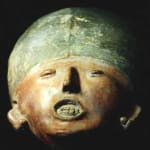Nayarit Terracotta Mask, 300 BCE - 300 CE
Terracotta
8
PF.3366
This small terracotta mask comes from the late pre-classic period in Nayarit, west Mexico. Portraying the typical Nayarit sculptural features such as small slit eyes, small mouth, and large forehead,...
This small terracotta mask comes from the late pre-classic period in Nayarit, west Mexico. Portraying the typical Nayarit sculptural features such as small slit eyes, small mouth, and large forehead, the mask's expressionistic quality delights the viewers' curious eyes. Red slipped and well burnished, the face seems to glow with warm color of orange-red. Moreover, the large forehead creates an interesting contrast with the small, sharp chin. The mouth is open to reveal intricately sculpted teeth that appear to be clenched. Wearing beautiful ear spools, this intricate mask most likely represented or was used by a wealthy and important person in the Nayarit society. Because the eyes of the mask are not perforated, it was not worn by ritual performers but functioned as a pectoral or have been placed over the face of the deceased. Considering the small size of the mask, it perhaps was modeled after a child's face. Although we do not know who this child is, we can imagine how precious the child was by this lovingly sculpted mask. Who wanted to remember this child so much to wear his mask as a pectoral? Or maybe the mask accompanied the deceased child in his shaft-tomb. As we look into the intricate beauty of the Ancient sculpture, we realize peoples' attempts to remember their loved ones remains the same now as more than a thousand years ago.



